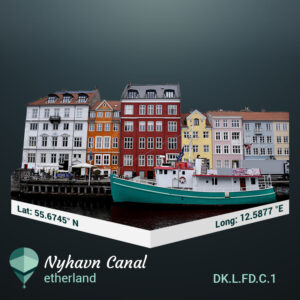 The Nyhavn Canal of Copenhagen was built from 1670 to 1675 under the rule of King Christian V, as a way to access the old inner city from the sea. It does not only offer some of the best views in Denmark, the canal district itself is spectacular. It is lined with bars and restaurants and in warm weather, the outdoor seating and waterfront restaurants can get crowded.
The Nyhavn Canal of Copenhagen was built from 1670 to 1675 under the rule of King Christian V, as a way to access the old inner city from the sea. It does not only offer some of the best views in Denmark, the canal district itself is spectacular. It is lined with bars and restaurants and in warm weather, the outdoor seating and waterfront restaurants can get crowded.
The Nyhavn Canal, meaning the ‘New Harbour Canal’, in Copenhagen was built in the 1670s under the direction of King Christian V of Denmark. Between 1658 and 1660, Denmark, which was united with Norway at the time, had been at war with Sweden. Thousands of Swedish prisoners of war remained in Danish captivity for years afterward, and in the 1670s, these were put to work digging out the monument. The Canal runs from the harbour and the Royal Playhouse to the old city around the region known as King’s Square, stretching in total a distance of some 450 meters. It is memorable today for the line of old colorful houses which lie along the waterfront and give it a distinctive look. The first of these was built in 1681, shortly after the completion of the water route and many more quickly appeared. Famously, the great Danish author Hans Christian Andersen lived at No. 67 during the mid-nineteenth century, where he wrote some of his most well-known works such as The Two Baronesses.
For many years Nyhavn was the site of some of the more boisterous sides of Copenhagen life, as it was near the dockyards and became the site of drunken sailors in revelry and of prostitution. It was known as an area which people should avoid and where thieves and pickpockets plied their trades also. There was also a flourishing black market for goods out of the newly arrived ships that needed to be sold in an extra-legal fashion. One of the legends surrounding the monument is that in the eighteenth and nineteenth century the city authorities came to an uneasy agreement with the less reputable business interests of Nyhavn that one side of the waterfront by the canal would be for ‘decent’ society and the other would be for the shadier business interests who would not be disturbed as long as they stayed to their side.
However, beginning in the mid-nineteenth century, the Nyhavn area was gentrified. The first footbridge, a wooden construct, was extended across the Canal in 1874, and in 1912 just prior to the outbreak of the First World War a more permanent bridge which still stands there was established. This was around the same time that the canal started to be deserted by any ships docking goods into Copenhagen as new bridges and roads across Denmark’s islands saw goods being brought into the city by car, truck, and train. As a result, the area was further converted into a tourist attraction in more recent times. The quay was pedestrianised in 1980, three years after the Veteran Ship and Museum Harbour had been founded on the waterfront.